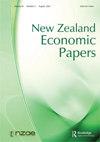新西兰大都市和非大都市地区的国际移民和收入分配
IF 0.7
Q3 ECONOMICS
引用次数: 0
摘要
自20世纪90年代以来,新西兰的移民数量出现了强劲增长,直到2019冠状病毒病大流行引发了为期两年的移民接近零的阶段。人们越来越关注移民对各种社会和经济结果的影响,因此需要对证据和相关政策进行审查。一个值得关注的领域是移民对收入分配的影响程度,因为自20世纪80年代以来,不平等现象明显加剧。在本文中,我们考虑到移民在空间上的选择性,并比较了移民群体(包括新西兰出生的从国外归来的人)对大都市地区收入不平等的贡献与非大都市地区的贡献。我们使用了两种不同的分解方法并比较了结果。我们发现,通过这两种方法,移民群体对整体收入不平等做出了不平等加剧的贡献。这些贡献在大都市地区比在其他城市更大。然而,技能分配的变化,包括移民带来的变化,对收入分配有着更重要的影响。高技能群体(无论是在新西兰出生的还是在外国出生的)对收入分配的不平等做出了越来越大的贡献,尤其是在大都市地区。本文章由计算机程序翻译,如有差异,请以英文原文为准。
International migration and income distribution in New Zealand metropolitan and non-metropolitan areas
ABSTRACT New Zealand experienced strong growth in immigration since the 1990s, until the COVID-19 pandemic triggered a two-year phase of near-zero migration. Growing concern about the impact of immigration on various social and economic outcomes has led to a review of the evidence and related policies. One area of concern is the extent to which immigration impacts on the distribution of income - given that inequality increased notably since the 1980s. In this paper we take into account that immigration is spatially selective and compare the contribution of migrant groups (including New Zealand born persons returning from abroad) to income inequality in metropolitan areas with that contribution in non-metropolitan urban areas. We use two different decomposition methods and compare results. We find with both methods that migrant groups made inequality-increasing contributions to overall income inequality. These contributions are larger in metropolitan areas than in other urban. However, changes in the skill distribution, including those brought about by immigration, have more important implications for the distribution of income. High-skilled groups (whether New Zealand born or foreign born) have made inequality-increasing contributions to the distribution of income, particularly in metropolitan areas.
求助全文
通过发布文献求助,成功后即可免费获取论文全文。
去求助
来源期刊

New Zealand Economic Papers
Economics, Econometrics and Finance-Economics, Econometrics and Finance (all)
CiteScore
1.20
自引率
0.00%
发文量
17
 求助内容:
求助内容: 应助结果提醒方式:
应助结果提醒方式:


